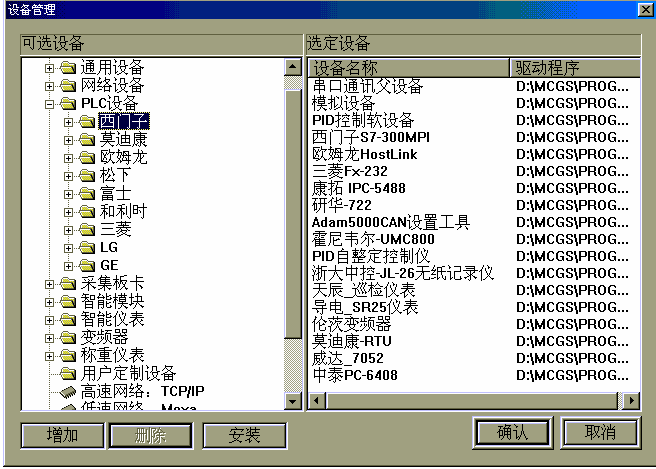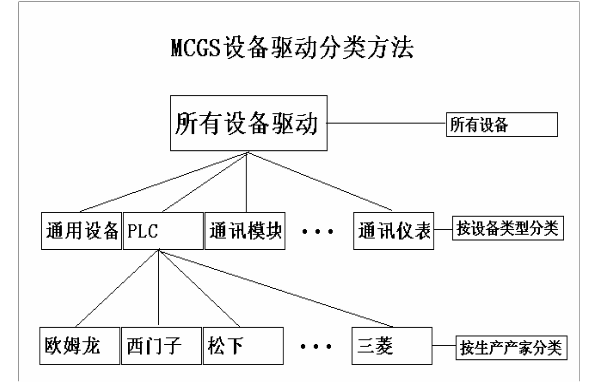The device window is an important part of the MCGS system. It is responsible for establishing the connection between the system and external hardware devices, enabling the MCGS to read data from external devices and control the working state of the external devices to realize real-time monitoring of industrial processes.
MCGS implements the basic method of device driver: Configure different types of device components in the device window, and set related properties according to the type and characteristics of the external device, and operate the device, such as hardware parameter configuration, data conversion, device debugging. They are all encapsulated within the component and are connected to the external device to establish a data transmission channel in the form of an object. During the system operation, the device components are uniformly scheduled and managed by the device window, and the data collected from the external device is provided to the real-time database through the channel connection, the control parameters are queried from the real-time database, and sent to other parts of the system for control operation and process scheduling. Real-time detection of the working state of the device and automatic control of the process.
This structure of MCGS makes it a device-independent system. For different hardware devices, you only need to customize the corresponding device components, place them in the device window, and set related properties. The system can then perform the device. Operation without any changes to the overall system structure.
In the MCGS stand-alone version, only one device window is allowed in a user project and is set in the main control window. At runtime, the main control window is responsible for opening the device window. The device window is an invisible window that runs independently in the background and is responsible for managing and scheduling the operation of device driver components.
Because MCGS uses an open structure for processing the device, in practical applications, it is convenient to customize and add the required equipment components, and continuously enrich the equipment toolbox. MCGS will gradually provide equipment components corresponding to the industrial control products commonly used at home and abroad. At the same time, MCGS also provides an interface standard for users to use the Visual Basic or Visual C++ programming tools to compile the required equipment components and load the MCGS equipment tools. Inside the box. MCGS provides an advanced development wizard that automatically generates a framework for device drivers for users.
In order to facilitate the custom engineering user to quickly develop and develop specific device drivers, the MCGS system also provides the source code of the typical device driver of the system. Users can transplant and modify these source code to generate their own device drivers. For device drivers that have been programmed,
MCGS is managed using the device component management tool. Click on the “Device Component Management Item†under the MCGS “Tools†menu. The “Device Management†window as shown below will pop up:

The main function of the device management tool is to facilitate users to quickly find the device driver that suits them in hundreds of device drivers, and complete the registration and deletion registration of the selected device in Windows.
Registration and deletion registration of the MCGS device driver. Before using the MCGS device for the first time or the user's own new device, the device driver registration must be completed as follows. Otherwise, unpredictable errors may occur.
Device driver registration method: As shown in the figure, all the devices currently supported by MCGS are listed on the left side of the window. All registered devices are listed on the right side of the window. Users only need to select the device to be used in the list box on the left side of the window. Press the “Add†button to complete the registration of the MCGS device. Select the device to be deleted in the list box on the right side of the window and press the Delete button to complete the deletion registration of the MCGS device.
The MCGS device driver selection, as shown in the figure, lists all MCGS devices (all devices in the MCGS Program Derives directory) in the list box on the left side of the window. The optional devices are sorted according to a certain classification method. Users can According to the classification method to find the equipment that you need, for example, if you want to find the driver of the Kangtuo IPC-5488 acquisition template, you need to find the collection template directory, then find the Kangtuo card catalog in the collection template directory, and then in Kangtuo. The device under the board directory can be found under the installation button to install other directories (non-MCGS IPC-5488.\ProgramDerives directory).
The classification method of equipment catalogue, in order to facilitate the user to find the required equipment in many equipment drivers, drive MCGSMCGS. All equipment drivers are arranged according to reasonable classification methods. The classification method is shown in the following figure:

MCGS supports the following series of PLC devices:
Siemens S7 200 (free port, PPI interface), S7_ 300 (MPI interface; Profibus interface), S7_400 (MPI interface, Profibus interface);
Modicon-Modbus-RTU protocol, Modbus-ASCII protocol, Modbus-Plus protocol;
Omron CQM series, C200 series, CS series and CV series;
Mitsubishi EX Series, AnA Series
Panasonic FPO, FP1, to FP10 series.
Delta SC500/OMC-1 series, Open_PLC XC_2000 series
LG_ LG_ MK S series;
GE_90 series
AB full range
Fuji NB series
Hollysys full range
The Mining Transformer,Mining Transformer,Electric Power Transformer,Electric Transformer
SANON DOTRANSÂ Co., Ltd. , https://www.sntctransformer.com